
My winter squash has what Mud Baron once described as “jock itch for plants:” powdery mildew. I’ve tried all kinds of notions and potions in the past, but this year I decided to see what the science says about powdery mildew. Our climate where I live in Los Angeles is, unfortunately, ideal for producing this vexing fungus.
IPM
Let’s begin with some condensed advice from UC Davis’ Integrated Pest Management page:
Preventative measures:
- grow resistant varieties
- find a sunnier spot for the vegetable garden
- back off on nitrogen
Non-chemical approaches
- sprinkle plants with water mid morning–add soap for more effectiveness
- remove infected leaves promptly and dispose of them
Fungicides:
- apply horticultural oil, neem oil or jojoba oil if the temperature is under 90° F. Do not apply any of these oils if you have used sulfur.
DIY Options
For home remedies I turned to advice from Washington State University horticulturalist Linda Chalker-Scott.
How about milk, widely touted as a powdery mildew treatment? According to Chalker-Scott the answer is yes it might work, but you may need to apply milk before powdery mildew appears. And the studies were done with whole milk, so the effectiveness of other kinds of milk have not been tested. Milk has not worked for me in the past, probably because I applied it too late.
How about baking soda? Chalker-Scott is skeptical. Baking soda has never worked for me.
Compost tea? I hate to bring it up as the topic is insanely controversial. I discovered a tempest in a compost tea pot when I tried to write a non-partisan magazine article about it. Let’s just say I ended up leaning towards the skeptical side when I looked at the evidence. Let me know if you think I’m wrong on this, especially if you can leave a link to a peer reviewed study.
Conclusions
What has definitely worked for me in the past is seeking out resistant varieties. I wasn’t smart enough to remember this fact so I’m going to try the soapy water approach and step up to something stronger if I have to. Part of my problem might also be too much nitrogen–my infected squash is in our straw bale garden and I had to apply a lot of blood meal to get it going. More sun would also help but that would involve cutting down a very large tree. I’ll update this post later in the season.
Let’s hear from you . . .
What powdery mildew treatment have you tried and how did it work? Leave a comment and join the conversation!
And I put the question out on the Root Simple twitter feed and got a few divergent opinions:
Christopher Kennedy @ckpfunk Bonide’s Copper Fungicide for organic gardening. I spray every 14 days this time of year instead of every other w/ baking soda.
Alec @Alec I’ve tried horsetail tea, sea-crop, baking soda, compost tea, and neem oil on mildew, but none compare to milk.
Alissa Walker @gelatobaby I just sprayed with a baking soda solution seems to have done the trick so far. And removed all damaged leaves.
Alex Mitchell @alexmitchelleg give the plants some air, water the ground not the leaves. Could spray diluted milk with water on leaves – never worked for me
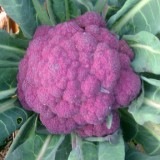
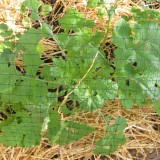
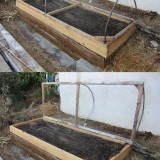

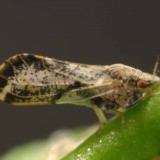
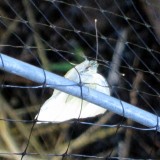
All of my squash plants in raised beds where I have been using drip emitters are doing great. The only problem plant with powdery mildew is in a front yard planting bed and is watered overhead by my lawn sprinklers.
Have you tried just ignoring it? I’ve been gardening for nearly 50 years and I’ve seen lots of powdery mildew. I’ve never done anything about it and I always have gotten what I considered a good yield of anything affected by it. In fact, I’ve never did anything for any crop except shake off Colorado Potato Beatles.
I’ve had good success combatting powdery mildew using a combination of baking soda, soap, oil, and vinegar sprayed on the leaves (1 gallon of water, 2 tbls baking soda, 1tbls soap/oil/vinegar, all added in the order listed). Seems to work wonders, but may take more than one application. I don’t even remember where I got the formula.
I agree with most of your thoughts in this article, Erik. My folks think NON-FAT milk is the way to go.
I do not spray. I try to grow what I need and when it dies from mildew, I yank ’em and have fresh plants started elsewhere. I do not spray any kind of soap or oil – that stuff drips off the plants to the soil – what does it do to critters in the soil? I am not willing to play that game – besides – what if you have lady bug eggs in your squash when you use soap or oil? I think spraying these non-benign substances is foolish and is born from our society’s pressure to DO SOMETHING NOW and is probably mostly counter-productive.
Another vote for trying drip irrigation…
I finally found a squash that does well for me in squash vine borer land–tatume–and it is not at all resistant to powdery mildew. I though growing it on a trellis would provide enough air flow, but I think I still had it too crowded. I was wondering what is effective also, but I think I’ll just remove the worst affected leaves, as it still seems to be producing fine.
I’ve had good luck with training my curcubits (gherkin and lemon cukes, Romanesco zucchini) up bamboo stakes. It’s only the leaves that get buried that get much mildew, and if they’re all exposed to wind and sun, the mildew stays at benign levels.
This year, powdery mildew hit my yellow and zucchini squash suddenly and intensely. I started spraying with 10 percent whole organic milk in water. This did not make the existing mildew retreat, but does seem to have halted new growth. I’ve been spraying cukes also, and no mildew on them yet.
I also dug up grass that was growing near the squash, on the theory that getting rid of vegetation that held dew/moisture near the squash leaves would be a good thing.
Do you have any varieties that are resistant you’d recommend? I tried the Success PM straight neck and did not seem resistant at all.
I’ve used milk with great success for a few years now. (Mine are on drip irrigation and still get it.) A roughly 50% solution, I’ve tried both whole and 2%, haven’t tried skim. Spray it on all the leaves, works great!
Marrone Bioinnovations offers a product called Regalia which is a knotweed extract. Effectiveness is very good for the home gardener.
Another vote for ignoring it. Here (pnw), I plant in as dry a place as possible (raised bed, full sun), and a healthy plant grows like stink all through June, July, and then usually toward the end of August, the powdery mildew starts to hit as the days get shorter and there’s more dew in the morning. But our season only goes until late October anyway, and by that time we expect the vines to have died and the squash to have (hopefully) cured “in the field”. No harm done. Powdery mildew just seems to be the norm up here, but as others say, doesn’t seem to affect the yield. So what’s the problem?
I propose a 3-step approach and hope to experiment with it myself in future years:
1.) Water from below as David King said above.
I think we should focus on building up our soil instead of spraying things that will most definitely change the composition of the soil.
With that in mind, rather than spray:
2.) Interplant the squash family with plants that have natural antifungal properties: garlic (and anything else from the allium family – onions, chives, etc.), lavender, coriander (and anything else from the carrot family), oregano, rosemary, thyme.
3.) I sprinkle calendula and sweet alyssum flower seeds in my squash family garden beds because they attract the beneficial insects that prey on cucumber and squash beetles.
I figure if a plant is weakened by either the fungus or the beetles, it’s bound to eventually come down with the other, so combat both as a preventative measure.
DISH WATER WORKS FOR APHIDS ONLY I THOUGHT, BUT WINDEX IS A MAGICAL JUICE FOR FUNGUS AMUNGUS ON PLANTS INSIDE SO MAYBE….
Our pumpkins had the same problem and I sort of haphazardly tried some remedies with milk and garlic spray for the leaves. Then I read in one of our German gardening books that mildew occurs when plants are getting too little water. I upped the watering. Problem solved. Are your squash getting enough water?
Hey Molly–thanks for the tip. I think they are getting enough water. I’ve been using soapy water and it seems to be working. We’ve also had a cooler than usual summer here which may have contributed to the problem.
The most effective solution I tried was horsetail tea. I tried it last year, the results were immediately visible the next day. The added benefit was the plant seemed to incredibly healthly after the spray, so it worked also as a foliar feed. This year I am trying it as a preventive and foliar feed. http://www.irievibeseeds.com/Organics